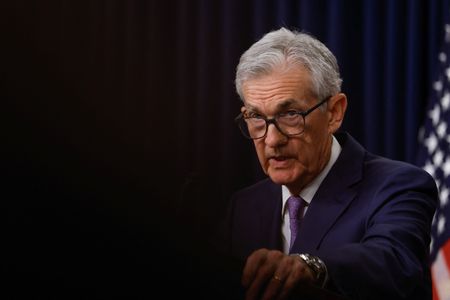By Balazs Koranyi and Howard Schneider
SINTRA, Portugal (Reuters) -The U.S. is back on a “disinflationary path,” Federal Reserve Chair Jerome Powell said on Tuesday, but policymakers need more data before cutting interest rates to verify that recent weaker inflation readings provide an accurate picture of the economy.
Data for May showed the Fed’s preferred measure of inflation did not increase at all that month, while the 12-month rate of price increases has ebbed to 2.6%, still above the U.S. central bank’s 2% target but on the way down after a scare in the first months of the year.
“We just want to understand that the levels that we’re seeing are a true reading on what is actually happening with underlying inflation,” Powell said at a monetary policy conference in Portugal sponsored by the European Central Bank.
“I think the last reading … and the one before it to a lesser suggest that we are getting back on the disinflationary path,” Powell said. “We want to be more confident that inflation is moving sustainably down toward 2% … before we start … loosening policy.”
Powell would not comment on when U.S. rate cuts might begin, but acknowledged the Fed has entered a sensitive phase in its deliberations in which the risks to its inflation and employment goals “have come back much closer to balance” – meaning neither can take full priority in setting policy.
In particular, some closely watched measures of the job market suggest the U.S. economy may be at a point where further progress on inflation will involve the sort of tradeoffs with rising unemployment that the Fed has so far avoided.
“You can’t know that with precision,” Powell said, “but it is understood that we have two-sided risks.”
The U.S. unemployment rate has been at or below 4% for more than two years, a fact that many Fed policymakers have used to argue for patience in deciding when to cut the central bank’s benchmark policy rate.
“Given the strength we see in the economy we can approach the question carefully,” Powell said, while also noting that policymakers don’t want to keep policy too tight for too long and “lose the expansion.”
‘WARNING SIGNS’
In separate comments to CNBC, Chicago Fed President Austan Goolsbee said he felt there were “warning signs that the real economy is weakening,” and though conditions still remain strong, the Fed needed to be careful not to keep monetary policy at such a tight level longer than needed.
The unemployment rate, while low by historical standards, has risen steadily from 3.4% in April of 2023 to 4% as of May. The U.S. Labor Department will release the monthly employment data for June on Friday.
The challenge for the Fed is deciding how and when to signal that a policy change is imminent, particularly given that further progress in lowering inflation is expected to be slow.
Powell said on Tuesday that inflation is not likely to be back at the 2% target until late next year or in 2026. But he also anticipated it will have fallen to between 2% and 2.5% a year from now, which he said would be a “great outcome.”
Goolsbee and others have argued that at some point falling inflation should trigger lower interest rates to keep the inflation-adjusted “real” cost of borrowing from increasing.
U.S. short-term interest-rate futures were little changed on Tuesday, with prices continuing to imply that the Fed would deliver its first rate cut in September and a second one in December.
The Fed has kept its benchmark policy interest rate steady in the 5.25%-5.5% range since last July, and still described inflation as “elevated” in its June 12 policy statement.
Whether the Fed ends up cutting in September or winds up on a more delayed timetable will hinge on coming employment and inflation reports, including the monthly jobs report on Friday and the July 11 release of the consumer price index for June.
The Fed will hold its next policy meeting on July 30-31.
While the timing of an initial rate cut may matter little to the larger economic outcomes the Fed is seeking, policymakers are sensitive to the signal they will send by cutting rates.
They want to be sure, in particular, that the first reduction in borrowing costs becomes the start of a full monetary easing cycle that brings rates steadily down to a level where the Fed feels it is neither encouraging nor discouraging businesses and households to invest and spend.
For many officials that has been an argument in favor of being patient and waiting longer to make the first rate cut.
(Reporting by Balazs Koranyi; additional reporting by Howard Schneider and Ann Saphir; editing by Paul Simao)





